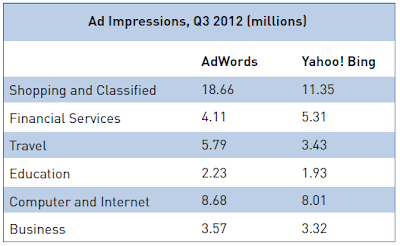Everybody knowing or having interest in search marketing would know that Google dominates search volumes. In the US of A, Google handles two-thirds of all search queries. However, can we ignore the network that accounts for one-thirds of the search queries that consumers type-in in the US?
The truth is that we know very little about the Yahoo-Bing Network (YBN).
This post is about a research done by AdGooRoo which sought to gauge the success of the YBN network in gaining market share against Google. The research report from AdGooRoo compared the performance of Yahoo! Bing against Google in six critical verticals.
Verticals basically referred to those industry segments that account for the majority of the total search traffic and click-throughs in the U.S. Search market. Comparing the paid search spends of these industry segments could give a representative idea of where each of the networks stand in terms of search effectiveness and outcomes.
The industry segments measured were as follows:
Bing Ads performed strongly against AdWords in several other verticals in terms of ad impressions. It outperformed AdWords in the Financial Services vertical with 5.31 million impressions compared to 4.11 million for AdWords. Analysts have credited the popularity of Financial Services on Yahoo! and MSN for pushing Bing Ads into the lead.
Click-Through Rates (CTRs)
In addition to earning more search traffic, advertisers on AdWords experienced higher CTRs on Google network, with AdWords campaigns getting 2.4 to 5.9 times higher CTRs than those on YBN during the same period.
Interestingly, for advertisers who were active on both the engines, quite a few of them got higher CTRs on YBN including Citicards and Fidelity Life. Quite obviously, it was found that among the 39,000 advertisers surveyed, 55% of them were running ad campaigns on both AdWords and YBN.
Otherwise, the competition in terms of CTRs was completely one-sided favoring Google. The biggest discrepancies came in Financial Services (3.53% compared to .81%), Travel (4.14% to 1.27%), and Business to Business (3.12% to .60%).
Not surprisingly, CPCs for YBN were invariably lower. There is a price to be paid for Google’s successful track record with AdWords. While CPC data was fairly close in each vertical, the Computer and Internet vertical saw a CPC rate on AdWords that was 117% greater than Bing Ads.
The truth is that we know very little about the Yahoo-Bing Network (YBN).
This post is about a research done by AdGooRoo which sought to gauge the success of the YBN network in gaining market share against Google. The research report from AdGooRoo compared the performance of Yahoo! Bing against Google in six critical verticals.
Verticals basically referred to those industry segments that account for the majority of the total search traffic and click-throughs in the U.S. Search market. Comparing the paid search spends of these industry segments could give a representative idea of where each of the networks stand in terms of search effectiveness and outcomes.
The industry segments measured were as follows:
- Retail (Shopping & Classifieds)
- Financial Services
- Travel
- Education
- Computer & Internet
- Business to Business
This methodology of dividing the spends into verticals was interesting. It brought up a number of questions, such as
- Which are the verticals where Google is dominant, and to what degree?
- Is Google dominant in every aspect of paid search - Impressions, Click through efficiency, CPC, CPL etc
- Can we compromise on impressions to get lower CPLs in some of the industry verticals? etc.
Impressions:
Google Adwords served more impressions in all the verticals except for 'Financial Services'. Retail as a vertical, is the biggest money-maker for advertisers and Bing was a distant second. The research was done in Q3, 2012 and Google had 7.3 million impressions more than YBN in one quarter alone, for 'Retail'.
Bing Ads performed strongly against AdWords in several other verticals in terms of ad impressions. It outperformed AdWords in the Financial Services vertical with 5.31 million impressions compared to 4.11 million for AdWords. Analysts have credited the popularity of Financial Services on Yahoo! and MSN for pushing Bing Ads into the lead.
Click-Through Rates (CTRs)
Interestingly, for advertisers who were active on both the engines, quite a few of them got higher CTRs on YBN including Citicards and Fidelity Life. Quite obviously, it was found that among the 39,000 advertisers surveyed, 55% of them were running ad campaigns on both AdWords and YBN.
Otherwise, the competition in terms of CTRs was completely one-sided favoring Google. The biggest discrepancies came in Financial Services (3.53% compared to .81%), Travel (4.14% to 1.27%), and Business to Business (3.12% to .60%).
Cost-per-Click (CPC)
Not surprisingly, CPCs for YBN were invariably lower. There is a price to be paid for Google’s successful track record with AdWords. While CPC data was fairly close in each vertical, the Computer and Internet vertical saw a CPC rate on AdWords that was 117% greater than Bing Ads.
As a result of lower CPCs, impressions were cheaper on the YBN. It varied from 76 to 90 percent cheaper on average. YBN therefore can be taken as a brand awareness medium giving high visibility at a lower cost.
For a lead generation campaign, YBN may not give high volumes, but can bring in leads at a lower cost per lead. It can prove to be very useful for brands who cannot handle high volumes of leads coming into the system.
Conclusions:
As an advertiser, I would suggest presence in both the networks. It would only put a multiplier effect on the search outcomes in terms of lowering of cost and increase in volume of leads.



No comments:
Post a Comment
Your comments will only make this blog richer in wisdom. Do drop a line even if it is just to say 'Good Post' :D